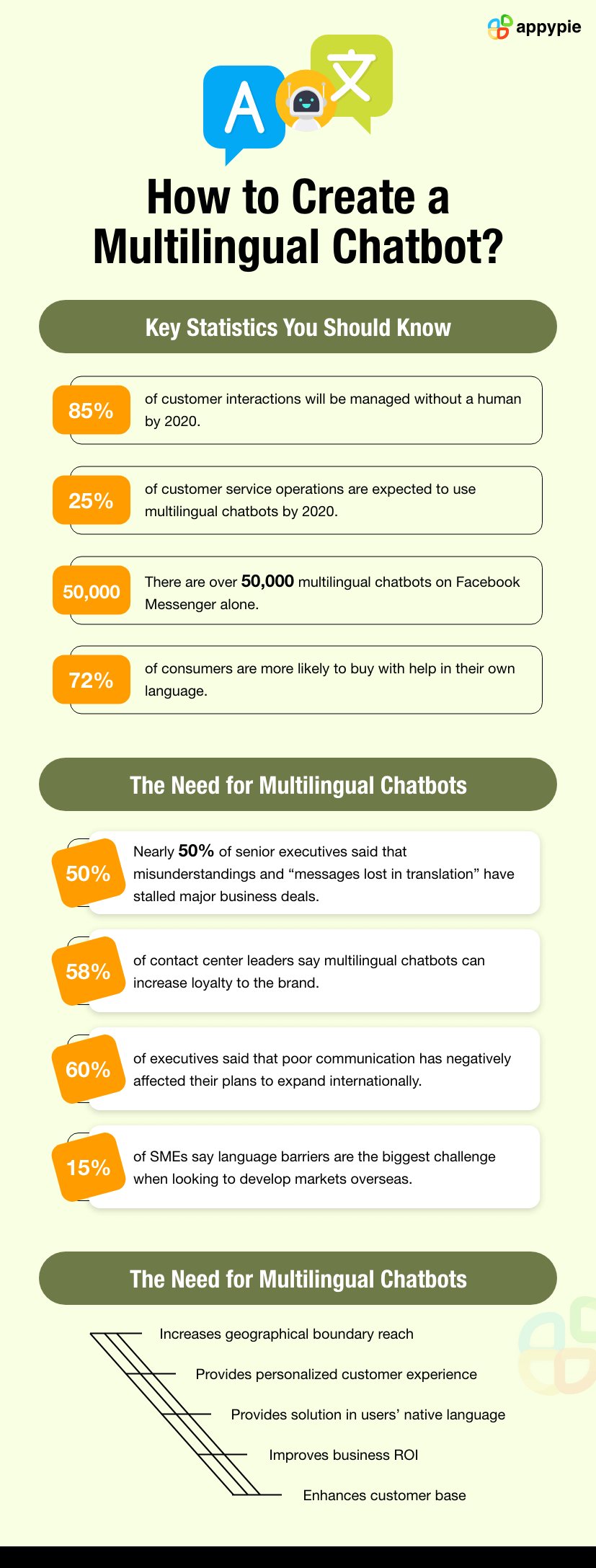How to Create a Multilingual Chatbot for Website?

Imagine you are shopping from some online e-commerce store. You encounter some issues with their products. And suddenly you noticed the chat window on the website asking, “Do you need any help?”. You typed your query in the chat window. Alas!! “I am unable to understand your language. Can you please type your query in English?”, chatbot replied.
Table of Contents
Do you realize how a language barrier can limit the reach of your business? Just a single language chatbot can be responsible for losing potential clients worldwide. Undoubtedly, AI-chatbots are important for your business but limiting their conversational flow to a single language might cost your business heavily. So, what’s the solution? A multilingual chatbot. In this blog, we will discuss why any business needs a multilingual chatbot for its website. Also, let us learn how to make a multilingual chatbot. Before proceeding ahead, we shall have a look at the infographic showing the statistics based on the importance of a multilingual chatbot.

What is a Multilingual Chatbot?
A multilingual chatbot is one of the jaw-dropping enhancements in the chatbot industry. The ability of a chatbot to understand and respond to the users’ queries in not just one but thousands of languages is just amazing! A multilingual or multilanguage chatbot is one that can offer multilanguage support to users’ during a live chat. It provides effective solutions to users in their preferred language. It can be easily integrated with a business website, mobile apps, and social media platforms to support users. If you are thinking about whether it would be worth an investment to create a multilingual chatbot for a website or integrate it with your mobile app, then you must continue reading the next section.Why Businesses Need Multilingual Chatbot For Website?
Every region across the world have their own native language. Most of the population is comfortable using their local language while communicating with others. No matter whether they are speaking to a chatbot or some friend, they first try to converse in their native language. That’s why to engage maximum users worldwide, a multilingual chatbot has become a necessity for every business website. A multilingual chatbot can contribute extensively to the growth and revenue of any business. With the technological advancements and availability of no-code platforms, it has become the pocket-friendly process to create and install chatbot. A chatbot that can converse the users from different corners of the world in their preferred language can’t fail to increase the conversion and retention rates. Undoubtedly, users prefer their first language while conversing with chatbots on any business website. So, if you want your business to progress and become popular worldwide, you need to invest in multilingual chatbots.What are the Benefits of Multilingual Chatbot?
To localize your brand, multilingual chatbots are highly effective and pocket-friendly solutions. Creating a chatbot that supports multi-language can benefit your business in numerous ways. Let us have a look at some of the major of them.Building a multilingual chatbot would help your business expand the outreach worldwide and cater to the needs of users in their first language.
Growing the customer base with a multilanguage chatbot won’t remain a challenge for business. Showcasing products, answering the user’s queries, and moving them down to the marketing funnel can be easily achieved by a multilingual chatbot.
Integrating a chatbot that supports multiple languages will certainly help improve the customer experience. It would create a seamless and smooth shopping experience for users. It has been proved in a survey performed on online shoppers that 75% of them love to make purchases from the stores available in their own language.
Creating a multilingual chatbot for your business can be a smart move to stand out among your competitors. If a bot speaks in the customer’s preferred language, it can help in improving customer support and gaining an edge over the competitors.
Saving time, energy, and resources can become easy for businesses after creating a multilingual chatbot for the website. Handling a multilingual customer base in every domain from marketing to sales to support would be effortless with multilanguage chatbots.
How to make a Multilingual Chatbot?
Creating a chatbot from scratch might be difficult for any business. However, this does not mean that you lose the opportunity to harness the benefits of multilingual chatbots. With the technological advancements, without even coding a single line, you can create your own multilingual chatbot in minutes. No-code platforms available online are the one-stop solution for all your chatbot development needs. These platforms are affordable solutions to create a chatbot. Among the hundreds of platforms available online, we recommend you go with Appy Pie Chatbot Builder. Appy Pie Chatbot Builder lets you build a chatbot supporting multiple languages within a few clicks. Irrespective of your professional coding knowledge and budget, it can help in building the out-of-the-box chatbots for your business website. Thus, if you wish to improve your customer experience and engagement, gain better users’ insights and reduce operational costs, you must try Appy Pie Chatbot Builder today!Summing Up
Don’t let the language become a barrier in success of your business. You can easily create and integrate a multilingual chatbot to your website. When globalization has allowed you to take your business across the globe, just push your limits. And now when you have no-code platforms available online to develop chatbots supporting multilanguage, you must definitely take a shot! With the implementation of a chatbot, you can get in sync with technology and become the first choice of your target audience. Also, you can create the chatbot metrics and analyze various parameters to boost your business across the world. Try Appy Pie Chatbot Builder today! Leave us the comments if you still think creating a multilingual chatbot is a challenge. We would love to help you!Related Articles
- How to Integrate MailChimp with Google Forms for Effective Market Research?
- Top 5 Form Building Software to Accept Payments in 2023
- A Step-by-Step Tutorial to Your Disney Plus Subscription Cancellation
- Top 5 Vimeo Integrations For Your Business
- 11 Top Font Trends to Try in 2024: A Journey into Digital Design
- Pastel Red Color: Meaning, Shades, And HEX Code
- How to Create Color Blind-Friendly Palettes: A Guide to Enhancing Chart Accessibility
- An Introduction to WhatsApp Chatbots
- Guide to Using Apple LiveText and Copying Text from Photos & Videos
- Tips and Techniques for Incorporating Coffee Pot Color in Graphic Design
Most Popular Posts
- 11 Reasons Why You Should Use Brochures for Business Marketing
- Top ConvertKit Integrations for Streamlined Email Marketing
- A Survey on Large Language Models with Multilingualism: Recent Advances and New Frontiers
- 10 Best AI Image to Animation Generators in 2024
- Top 9 AI Video Generator Tools in 2023: Ranked as the Best
